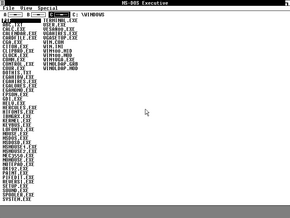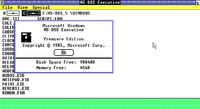Windows 1.0 Premiere Edition
| Build of Windows 1.0 | |
 | |
| Release name | Premiere Edition |
|---|---|
| OS family | 16-bit Windows |
| Version number | 1.00 |
| Architecture | x86 16-bit |
| Compiled on | 1985-07-30 |
| About dialog | |
Windows 1.0 Premiere Edition is a pre-release version of Windows 1.0, compiled on 30 July 1985. Microsoft originally distributed it to key players in the computer industry to prove their product wasn't vaporware, as the release date had been delayed several times since the original announcement on 10 November 1983. Before releasing the official final version, designated as version 1.01, the memory management code had to be completely rewritten; this would be the key difference between Premiere and 1.01.
This build is very similar to the Windows 1.0 Beta Release from May 1985 in terms of user interface. Its default color scheme is mostly black and white, although many of the bundled in applications actually use color with an appropriate combination of video adapter and drivers. About dialogs in the Premiere Edition make use of text figures, which can also be seen in the Beta Release.
Countless fake builds claiming to be the Premiere Edition appeared online in 2008, following the discovery of a photo featuring its boot screen on Microsoft's FTP server. In March 2014, BetaArchive user trueyanksfan claimed to have the real PE floppy disks and also posted a photo of them. It was later discovered that his disks were partially overwritten with other data, including a later build from October 1985. On 18 December 2014, a set of disk images from the real Premiere Edition was released by BetaArchive user Alias.
Photo from Microsoft's FTP[edit | edit source]
A photo of an IBM PC/AT (model 5170) seemingly running this build was available on Microsoft's public FTP server[1] and was also widely featured on various websites. However, there are doubts whether the photo is actually real and not modified by an image editing program. It's been pointed out the image on the monitor is too clear, bright, and flat to be a genuine photograph of that specific monitor (the IBM Enhanced Color Display, model 5154). Others have disagreed though, instead suggesting the photo was taken by a professional photographer.
Tandy Trower's article[edit | edit source]
In a three-part post titled The Secret Origin of Windows,[2] Tandy Trower, the last project manager for Windows 1.0, described the Premiere Edition:
But by the early summer of 1985, we were still not close to being done, so Steve [Ballmer] declared we should release a preliminary release that I dubbed the Premiere Edition, which we provided to key application vendors, analysts, and members of the press for feedback and in partial fulfillment of Ballmer’s promise to ship the product that summer.
— Tandy Trower
At the time, Windows' release date had been postponed several times, leading some people to conclude it had become vaporware (software whose release is promised but never actually followed through). This lead Microsoft to make the decision of releasing a preliminary version before it was completed, which they dubbed the Premiere Edition.
In the same article, Trower also mentions that:
Then just at the point I was starting to feel more optimistic about wrapping things up the architect of the memory management code told me he found a critical defect in its design and would need to re-write it, basically rendering all testing to date useless.
— Tandy Trower
Additionally, he discusses the release of the rewritten Windows 1.0:
By November, we had finished testing and come up with a solid release. [...] That release, being after the earlier “Premiere” release, was known as version 1.01.
— Tandy Trower
That implies that there was no final release designated as 1.00, making 1.01 the first truly public release, since Premiere Edition was a limited preview.
Fake build[edit | edit source]
A fake build claiming to be the Premiere Edition appeared online in 2008 and was available on BetaArchive for years before it was removed,[3] but can still be found on many other websites. That build has since been confirmed as fake for the following reasons:
- Microsoft's developers stated that the entire memory management system had been rewritten between Premiere Edition and Windows 1.01, yet the leaked build's kernel is byte-wise identical to that of 1.01. Even the smallest code change would show signs that this version was different, but apparently nothing had changed between the fake version and 1.01 despite that.
- The version provided to BetaArchive originally included the file
WRITE.DAT(a file used by Windows Write), which was not originally part of the Premiere Edition. The leaker stated that it was a "mistake" and that Write was there only as an experiment. It was later removed in a re-upload, but the original tampering brought the build's legitimacy into question. - The leak originated from user betaguy224, who had a questionable past of providing fake material.
Discovery[edit | edit source]
On 29 November 2014, a BetaArchive user named Alias, who was an intern at Microsoft in 1985, posted a picture of the full disk set and the build running on his IBM PC/XT.[4] Alias has since shared the genuine version of Windows Premiere Edition with the community. It was made available on BetaArchive to everyone without the need for FTP access.[5]
InfoWorld article[edit | edit source]
In Issue 26, Volume 7 of InfoWorld magazine (dated 1 July 1985), an article called "Microsoft Ships Windows" was published.[6] The article's contents agreed with Tandy Trower's statements, ranging from the release date to certain details (such as the software being given out to "software developers" and "independent software vendors"). It does not, however, mention the name "Premiere Edition" anywhere.
Gallery[edit | edit source]
Reversi and first move is an Illegal Move
Media[edit | edit source]
Other sources[edit | edit source]
Stephen Manes and Paul Andrews (1993), Gates, New York: Doubleday, ISBN 0385420757 (a snip talking about premiere)
References[edit | edit source]
- ↑ ftp://ftp.microsoft.com/Services/Museum/Karin/44000001003770.TIF
- ↑ http://technologizer.com/2010/03/08/the-secret-origin-of-windows/2/
- ↑ https://www.betaarchive.com/forum/viewtopic.php?f=59&t=29459
- ↑ http://www.betaarchive.com/forum/viewtopic.php?f=59&t=33024
- ↑ https://www.betaarchive.com/forum/viewtopic.php?f=1&t=33172
- ↑ http://books.google.com/books?id=EC8EAAAAMBAJ&pg=PA16


























![x86 English floppy disk 1 of 4 [Setup disk]](/images/thumb/3/31/Windows1.0-Premiere-Edition-Disk1.jpg/120px-Windows1.0-Premiere-Edition-Disk1.jpg)
![x86 English floppy disk 2 of 4 [Build disk]](/images/thumb/6/60/Windows1.0-Premiere-Edition-Disk2.jpg/120px-Windows1.0-Premiere-Edition-Disk2.jpg)
![x86 English floppy disk 3 of 4 [Utilities disk]](/images/thumb/8/8a/Windows1.0-Premiere-Edition-Disk3.jpg/120px-Windows1.0-Premiere-Edition-Disk3.jpg)
![x86 English floppy disk 4 of 4 [Desktop Applications disk]](/images/thumb/a/a2/Windows1.0-Premiere-Edition-Disk4.jpg/120px-Windows1.0-Premiere-Edition-Disk4.jpg)